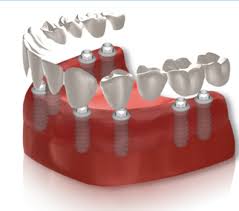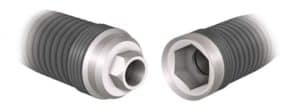
What is the best dental implant?
The best type of dental implant depends on the case situation and the patient. The implant that is best for one situation may not be best in a different clinical situation. For example a front tooth may be best replaced with a non metal zirconia implants because they are white. And a molar on the same patient may be best done with titanium because they are stronger.

full mouth dental implants 11
- Does the patient have any metal allergies or biocompatibility concerns with titanium?
- Is it a front tooth or a molar tooth implant?
- Is one tooth being replaced or is the implant for a full mouth of implants or All on 4 dental implants?
- Are there TMJ pain Issues and does the person clench or grind their teeth?
- Are the teeth tall or short? Big or Small?
- Are there metals in the mouth such as gold crowns, amalgam silver fillings, partial dentures?
- What kind of implant surgery is being done. Immediate implant placement on the same day as tooth removal. Implant surgery after a tooth has been missing for a significant period of time (3+months)
How does getting an implant work?
We all know new prosthetic teeth can be implanted into the jaw called dental implants. The invention of dental implants by Dr. Branemark was the surgical implantation of a titanium root form into bone. Dr. Branemark discovered that a titanium post surgically placed into the jaw resulted in growth and attachment of bone around the titanium post. We also know zirconia posts work the same way and non metal zirconia is also used in implant dentistry.
How to choose a dental implant
The best dental implant is the one that will perform the best in the specific clinical situation. A highly qualified implant specialist is the best person to determine what implant is best. But here are some good rules of them in implant selection:
- Zirconia implants may be more biocompatible than titanium implants and gum tissue grows better around zirconia than titanium.
- When using titanium implants, use a pure titanium implant surface rather than a titanium alloy. Alloys increase the chance of metal allergies and may contain nickel.
- Glued abutments make getting ideal results much more difficult and the technique is out dated. Modern day implants should not need glued abutments. In most cases a two piece screwed connection system is best.
- One piece implants fail at too high of a rate and getting cosmetic results is too difficult and not predictable.
- Internal connections lead to better cosmetic results than external connection implants.
- Metal-free zirconia implants look better for front teeth implants or any tooth visible in the smile zone. Zirconia are the cosmetic implants.
- Cases where people have small and short teeth are better done with titanium over zirconia implants
- Cases where people grind their teeth are better treated with titanium implants
- People with allergies and who are sensitive are better off with metal free zirconia implants because they are more biocompatible.
- Complex full mouth implant bridges such as All on 4 are better done with titanium implants.
- Snap-on dentures are better done with titanium implants
- Front teeth implants should be longer and not as wide
- Back teeth implants should be wider and not as long.
- Implant length should closely mimic the approximate length of the surrounding natural teeth
- Never buy a generic implant. Often these companies go out of business making finding future implant parts difficult if not impossible.
- Always use implants from a financially stable company because if the company sell out or goes out of business, you may not be able to get replacement parts. The implant will be unserviceable and un useable.
- Implants with deeper grooves and more taper are better same day all on 4 implants.
Best way to replace a full mouth of teeth with implants is All on 4 implants.
Full Mouth Dental Implants Video
How many different types of implants are available?
Teeth implants basically come in two different kinds of materials. Zirconia and titanium. Implants also come in many different sizes and shapes. Implants technically mimic the replacement of a tooth root. An implant is also sometimes called a “post.” Implant teeth are connected to implants by a part called an abutment. A major difference in teeth implants is that some connect to abutments in an area down and inside the implants whereas others connect on the outside and on top of the implant.
Internal vs External Hex Implant Connection

best dental implant 1 1
Advantages of Internal hex implant connection
These two different kinds of implants are called “internal” and “external” hex respectively. Hex because the parts typically connect by way of a hexagonal shaped fit. The hex is used to prevent rotation of the abutment about the implant. Dentists refer to this as an anti-rotational feature. Most implants today are “internal” because the design allows the implantologist to more easily create a beautiful implant tooth that emerges from below the gumline and that better resembles a natural tooth. An internal implant also makes a smoother transition between abutment and implant.
Disadvantages of External hex implant connection
External hex implant crowns sit on top of the implant. External hex implants usually connect at or above the gumline, leaving less room to create a good cosmetic result. External hex implants can be easier to clean.
Challenges of One Piece Dental Implants:
Some implant teeth are one piece implants where the implant directly makes the connection with the crown. In this case, the implant comes directly out of the bone and gum and into the mouth as one piece. In this case, it is necessary to drill the part sticking up into the mouth to customize its shape to facilitate a proper shape for fitting of an implant crown. A one piece implant creates a major disadvantage in two ways: 1) the implant is sticking up into the mouth after placement where the patient can hit it and cause implant failure prior to implant osseointegration or healing. 2) many teeth make a turn into the mouth where the root transitions to the crown. A one piece implant is always straight and makes it much more difficult for the implant dentist to create a nice looking crown.
Glued Two Piece Implants:
Some implants require an abutment to be glued to the implant. This glues connection is still used by many zirconia implant systems. The glue leaves another dental material and a new opportunity for biocompatibility issues. Additionally, a glued abutment needs to finished in the patients mouth. That means the dentist may need to drill the abutment in the mouth. A glued implant cannot ever be removed without drilling the abutment out of the implant. Such a removal can destroy the implant and result in a need to remove the implant.

 (301) 421 1996
(301) 421 1996 burtonsvillesmiles@gmail.com
burtonsvillesmiles@gmail.com